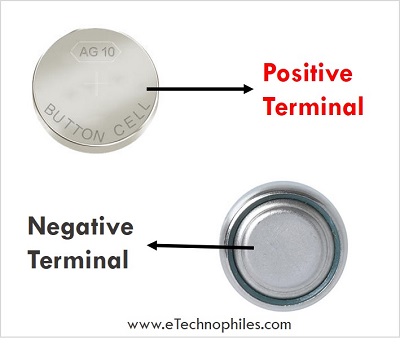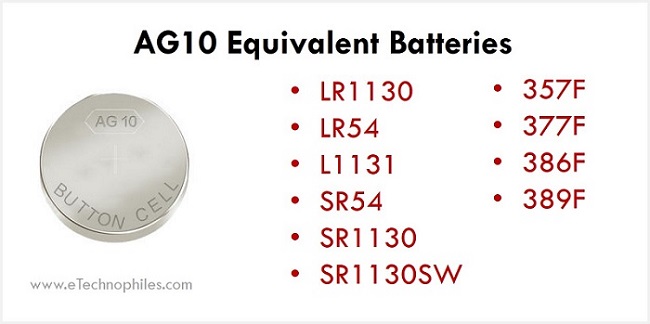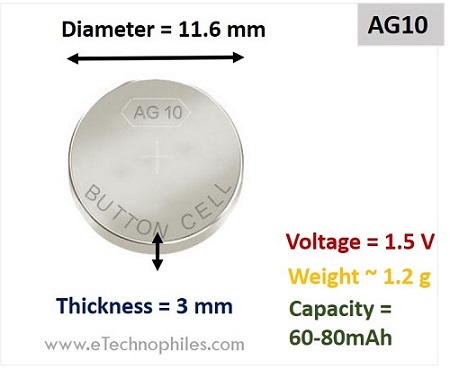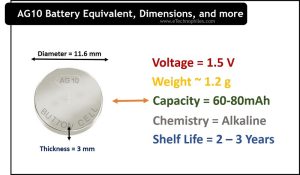Last updated on April 2nd, 2024 at 10:52 am
AG10 is a small and compact alkaline button-cell battery that is widely used in electronic devices such as calculators, watches, medical devices, small toys, etc. It has a diameter of 11.6mm and a thickness of 3mm.
It has a capacity of approximately 60-80mAh (a measure of how much it can store and deliver) and typically weighs around 1.0 to 1.2 gm. It can operate within a temperature range of -10 degrees Celsius to 60 degrees Celsius (14 degrees Fahrenheit to 140 degrees Fahrenheit).
Table of Contents
What does AG10 stand for?

The letters “A” and “G” in AG10 refer to the chemical composition used in the battery.
- The letter “A” stands for alkaline chemistry, a type of electrochemical reaction that produces electrical energy from the reaction between zinc and manganese dioxide.
- The letter “G” refers to the shape and size, which is cylindrical and small.
AG10 battery equivalent

The batteries with the same size and voltage rating as AG10 batteries are- LR1130, LR54, L1131, and 189.
Some silver oxide batteries are also equivalent to AG10. These batteries have twice the energy capacity of the alkaline ones and last longer (6-8 years depending on the usage). Some of them are SR54, SR1130, and SR1130SW.
However, if your project or device is not constrained to size and price, then you can go with other silver oxide batteries also, like 357F, 377F, 386F, 389F, etc.
Read also: LR41 Equivalent, Voltage, Size, Uses & Life
Specifications

The specifications of an AG10 battery are given in the table below.
| Parameters | Values |
| Voltage | 1.5V |
| Dimensions | 11.6mm (diameter), 3mm (thickness) |
| Cut-off voltage | 1.0-1.2V |
| Cell type | button cell |
| Capacity | 60-80mAh |
| Weight | 1.2gm approx |
| Temperature range | -10C to 60C |
Note: Unlike rechargeable batteries, the AG10 battery is a primary battery, which means it cannot be recharged. It usually lasts 2-3 years which is quite a lot depending upon the usage, but once the battery is fully discharged, it must be replaced. If you are designing a product then you should consider this point seriously.
Like all alkaline batteries, this battery is also prone to leakage if not handled properly. Factors that lead to leakage include high temperature, damage or punctures, being left in a device for too long, and natural chemical reactions in the battery over time can also cause leakage.
Despite this drawback, it is still an affordable option as compared to other types of button cell batteries such as silver oxide batteries. This is why it becomes a great option for powering small electronic devices that don’t require a lot of power.
Advantages and unique aspects of AG10
Long shelf life – AG10 batteries have a relatively long shelf life compared to other types of batteries, such as zinc-carbon batteries. This is because alkaline batteries have a slow discharge rate, which means they hold their charge for a longer period (around 3 years).
Widely available – These batteries are widely available in stores and online, making them a convenient option for replacing batteries in small electronic devices.
Low internal resistance – This point is for someone who spends most of his/her time developing electronic products. The internal resistance (5-10 ohm, depending upon the usage) of the AG10 battery is relatively low, which means it can deliver its power quickly, This makes it a good choice for devices that require a sudden burst of power, such as camera flashes.
Alkaline batteries are not considered very eco-friendly due to their chemical composition and also because they are not rechargeable. However, they do not contain heavy metals like mercury or cadmium.
Difference between AG10 and AG13
Both AG10 and AG13 are button-cell alkaline batteries but they are physically different. The diameter of both batteries is the same (11.6 mm), but AG13 is longer (5.4 mm) as compared to AG10 (3mm). There is a slight difference in the voltage of these batteries too, AG10 provides 1.5 volts and AG13 provides 1.55 V.
Conclusion: AG10 Battery
Overall, AG10 batteries are a reliable and affordable option for powering small electronic devices, however, it is important to handle them properly to avoid the risk of leakage and to be aware that they cannot be recharged.
